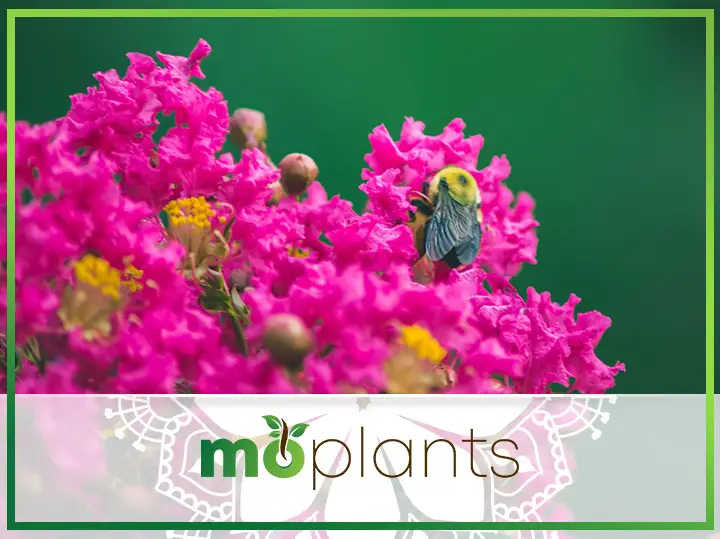Crepe Myrtles are one of the top picks for the South, with their stunning summertime blooms, handsome bark, plus stunning fall coloration, making them an all-rounder garden showstopper. Extended, chilly autumns produce amazing leaf displays, and Crepe Myrtle trees are among some of the easiest trees to maintain, which is a primary reason they are planted so often.
However, it is quite common for Crepe Myrtle leaves to turn brown. The truth is that there isn’t a single clear explanation for this discoloration.
But before you make any drastic decisions, it is important to check what time of the year it is.
Reasons Why Crepe Myrtle Leaves Turn Brown
Crepe Myrtle trees are more like shrubs and are highly resistant to drought and heat, and produce stunning flowers. These beautiful shrubs increase the aesthetic appeal of your garden; however, their leaves sometimes turn brown and die. There are several reasons this can happen, but first, we will discuss how different weather affects the Crepe Myrtle leaves differently.
Spring Season
Leaves of the Crepe Myrtle tree can turn brown in spring, which is rare, but it happens due to a sudden cold spell. Although many different shrubs can easily survive cold temperatures, the Crepe Myrtle shrub can’t. A sudden drop in temperature can also be fatal. It isn’t much you can do to avoid browning in this instance unless you grow your shrub in a shaded spot (this involves planning).
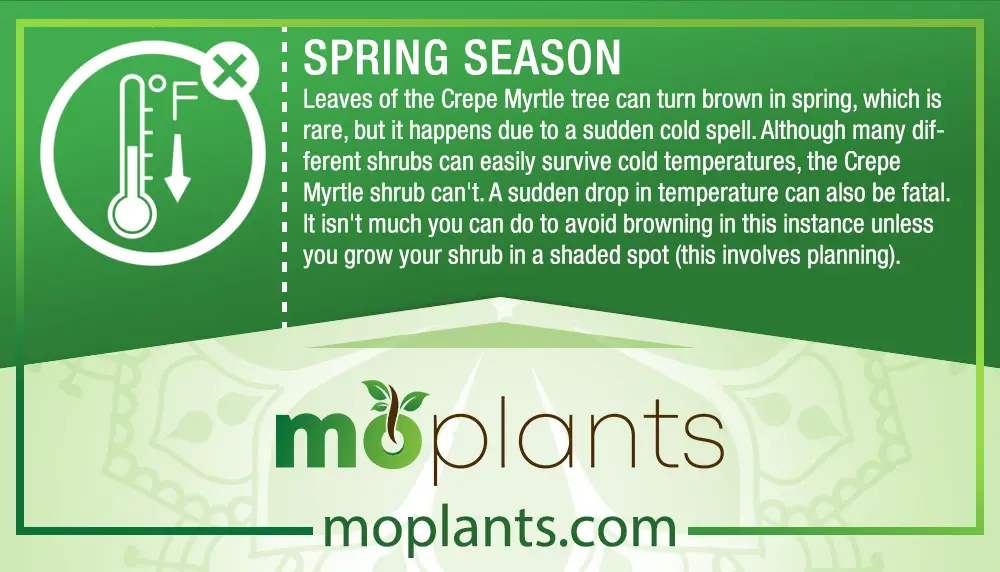
Summer Season
Although Crepe Myrtle trees are resilient and can survive hot summers, they do need to be watered frequently. If your Crepe Myrtle leaves start browning during the conclusion of a dry summer, it could be because of a lack of water. However, frequent watering can help to replenish the plant, and your Crepe Myrtle might recover from a heavy drought.
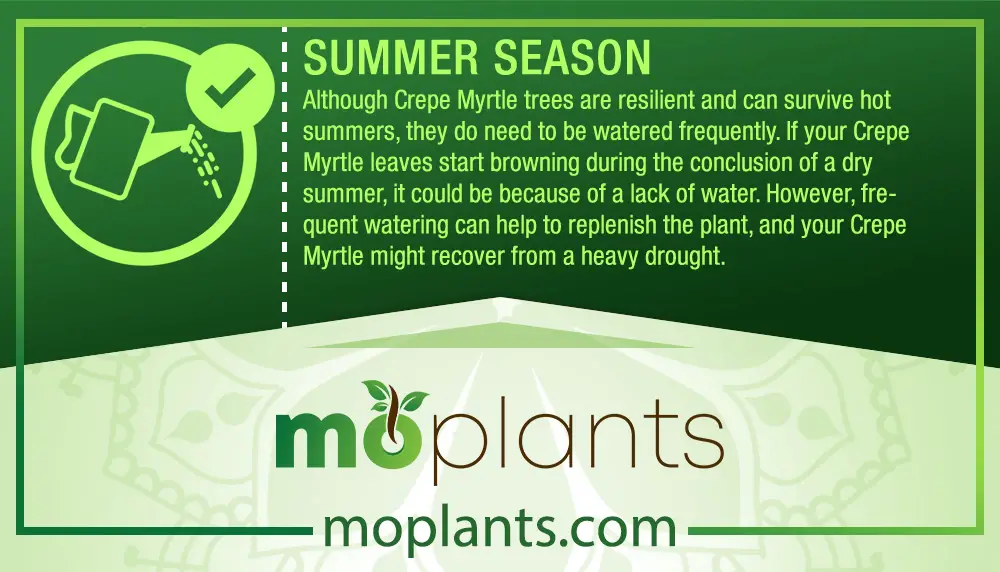
There are also other reasons that can lead to Crepe Myrtle leaves turning brown. There are as follows:
Aphids
Crepe Myrtles can easily be infested with Aphids. Aphids of the crape myrtle have a light greenish-yellow appearance with black dots on the underside. They survive the winter as eggs and hatch in the springtime. Every growing season, multiple offspring are created because it takes around 10 days to reach adulthood. The females again lay eggs just before winter, and the cycle carries on.
Aphids survive by sucking sap from the leaves with their mouth inserted into delicate young leaves. The sap fluid is rich in sugar and makes Aphids produce volumes of honeydew, which is like a sugary syrup that entirely covers the leaves.
As a result, the leaves are unable to absorb sunlight and turn brown and die. Another major problem the honeydew creates is it attracts several insects, including flies, insects, wasps, ants, and sooty mold fungus. Sooty mold fungus is another major problem that causes the browning of Crepe Myrtle leaves.
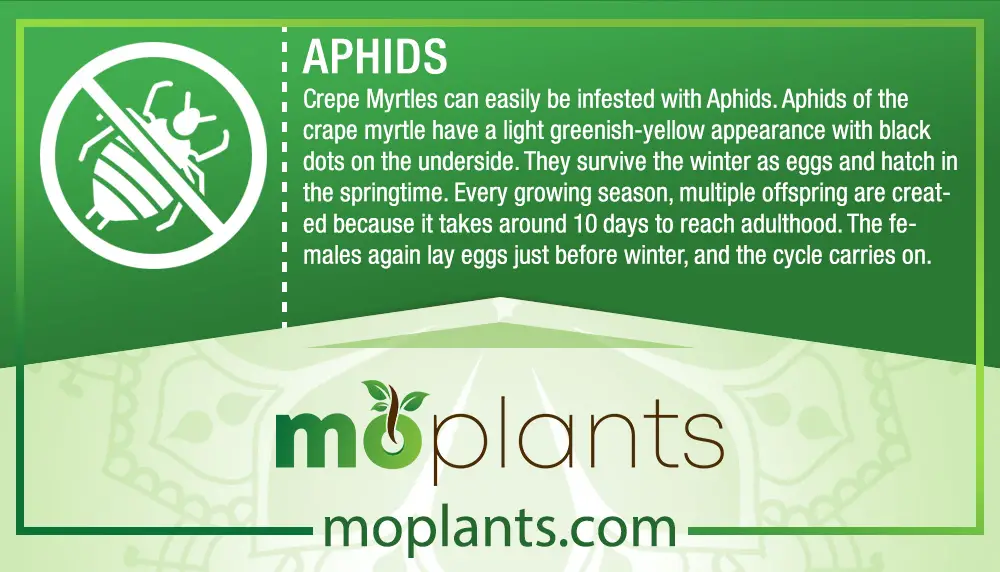
Treatment
You can combat an Aphid infestation with the help of predators. Using pesticides is not a wise option as Aphids reproduce very rapidly, and pesticides could end up harming the helpful predators and end up having no effect on the aphids.
Predators like ladybirds hover, fly maggots, green lacewings, entomopathogenic fungi, and parasitic wasps love to feed on Aphids. These natural predators and their larvae work efficiently in eliminating Aphids. Some aphids can also be eradicated by blasting them with a powerful stream of water.
Spray neem oil spray or dormant oil spray as a preventative strategy if aphid issues develop annually.
Limited Water
Crepe Myrtles thrive in wet soil. Limited water can cause Crepe Myrtles to be stressed and eventually cause the browning of leaves that fall off. This occurs during the summer months when it is very dry and rarely rains.
Water is necessary for Crepe Myrtles to grow; however, too much water is not good either. What results from this is an increase in the growth of leaves but a reduction in flowers.
It is important that you water your shrub with just the right quantity of water. To determine the quantity of water required, test the soil with a moisture meter. Generously water a new Crepe Myrtle with plenty of water after you first transfer it to the soil.
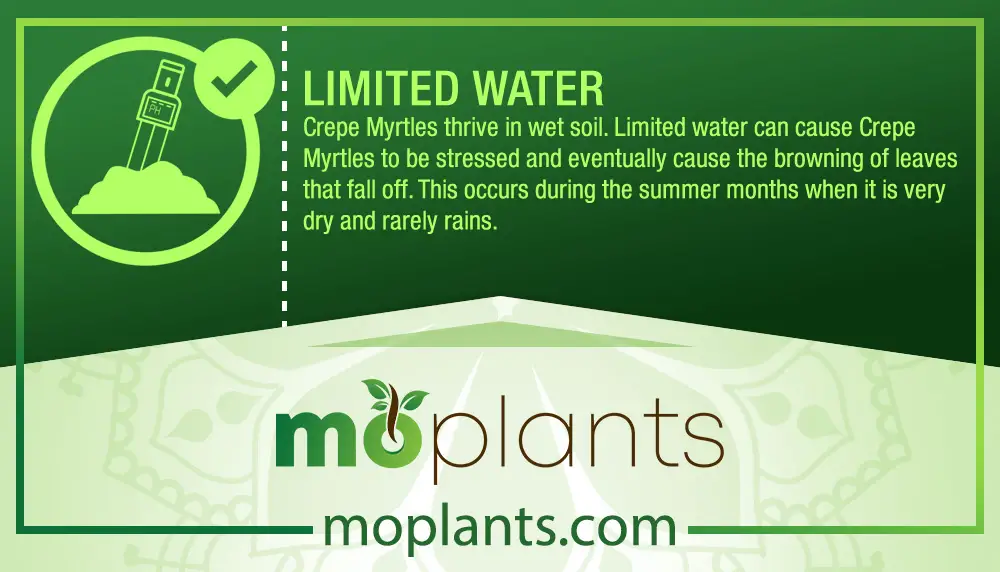
Too Much Fertilizer
Excessive fertilizer can cause the leaves to burn and become brown and brittle. This happens due to the extra nutrients in the soil. The roots find it hard to absorb necessary nutrients when they are more than their requirement. This results in the plant becoming deficient in nutrients and begins to turn brown or yellow.
In order to help your plant bloom and thrive, make sure you provide it with more phosphorus and potassium instead since Crepe Myrtles prefer them over nitrogen.
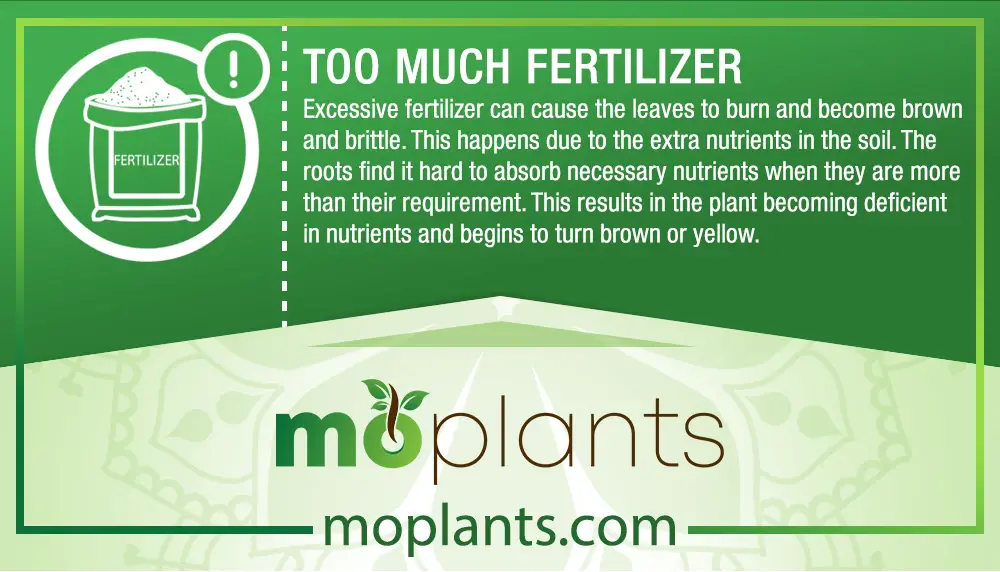
Crepe Myrtle Disease
This is one of the primary reasons for Crepe Myrtle leaves turning brown. It is caused by the Cercospora fungus and occurs mostly in regions with high humidity. This disease is indicated by brown spots appearing on the leaf. It is much different from Crepe Myrtle leaves browning due to weather or other natural issues; therefore, it is easy to spot.
This fungus mostly attacks older leaves and can completely foliage a plant during the end of summer and fall.
Apart from the brown spots, other common symptoms of the Cercospora disease are vivid autumn darkening of the leaves and premature yellowing leaves, beginning from the bottom and progressing upwards. These splotches of orange, yellow, and red occur due to toxins released by the fungus.
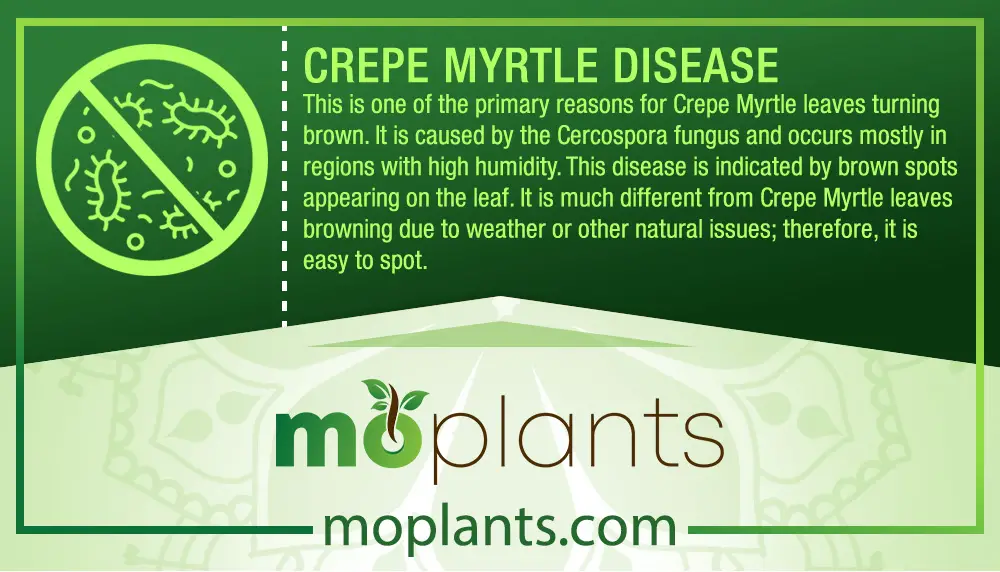
Treatment
Appropriate care, attention, and cultivation practices can treat Cercospora in Crepe Myrtle trees. Following is a guide for prevention and treatment of Crepe Myrtle disease:
- The Cercospora fungus thrives in water, and the Crepe Myrtle tree also needs a good quantity of water to be healthy. However, it is important that you water only the roots and not shower the shrub from above, as the fungus on the leaves will thrive even more.
- Humidity is fungus’s best friend; therefore, proper circulation between the leaves and branches is necessary. Increased air movement is an effective way to prevent as well as combat the spread of the fungus.
- If your Crepe Myrtle seems to be too congested, trim the branches closer to the bark and those that are criss-crossing each other; but be careful to use sterilized equipment as this will prevent the spread of the fungus.
- Changing compost on a regular basis also helps in the prevention of fungus. Getting rid of old mulch can also stop an infestation from reoccurring.
- You can also use a fungicide to treat the spread of Cercospora; however, you have to be completely sure your Crepe Myrtle has the infection.
- There are a few sprays you can make at home to get rid of the Cercospora from Crepe Myrtle leaves. A copper spray and a cinnamon spray work wonder in getting rid of the fungus and brown spots, restoring your Crepe Myrtle to its former glory.
Infographic
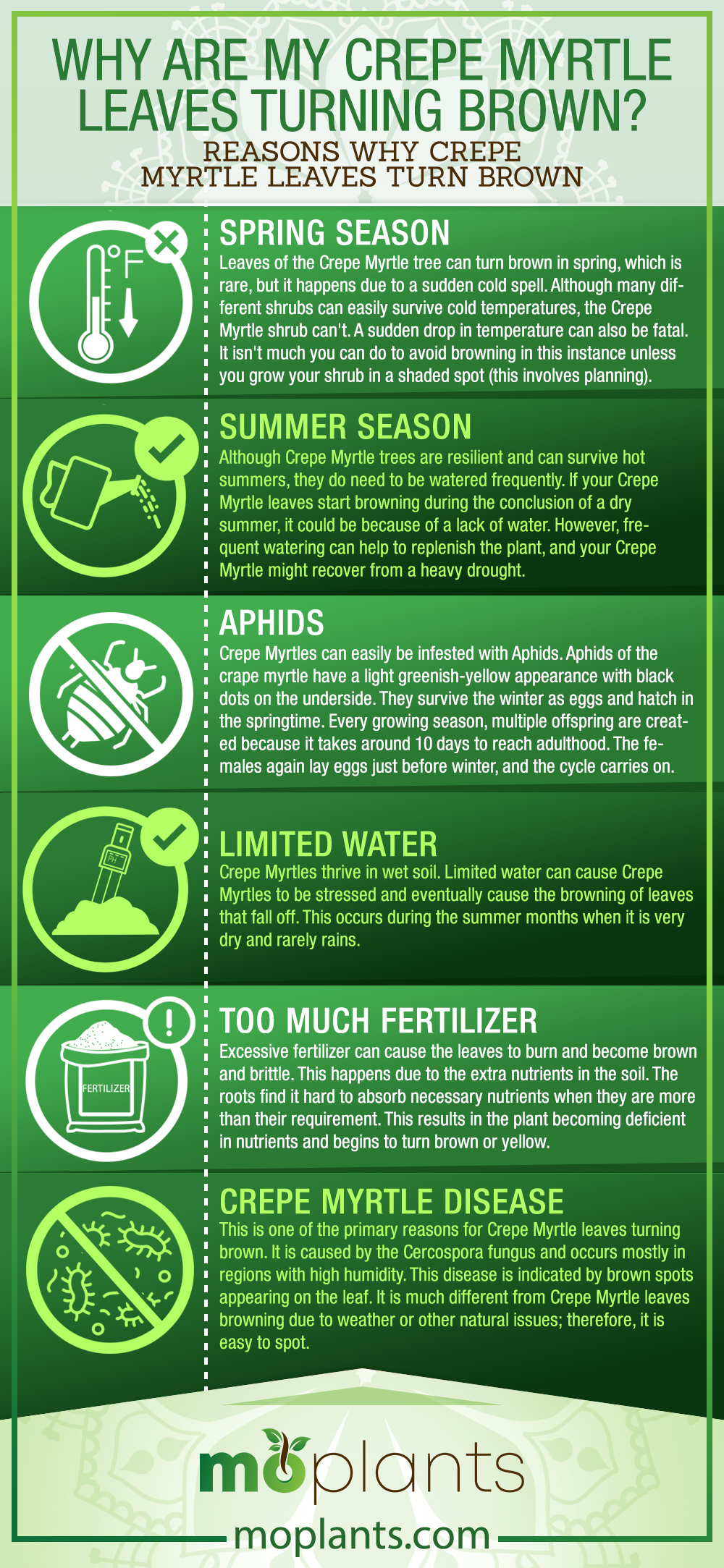
Crepe Myrtle Varieties
Since Crepe Myrtles are susceptible to a variety of diseases, and if it is not your forte to deal with them, you can choose a different tree or shrub entirely. On the other hand, Crepe Myrtles also come in several varieties that are resistant to browning leaves and fungi.
When you first decide to plant a Crepe Myrtle, choose a variety that is resistant. The varieties found to be resistant to Cercospora leaf spot are Tuscarora, Fantasy, Velma’s Royal Delight, Tonto, and Tuskegee. The level of resistance varies by region and is dependent on specific climatic factors. However, wherever you plan on planting the shrub, make sure it is not congested, and there is ample air circulation.
A few varieties are also resistant to Aphid, including Natchez, Acoma, Muskogee, Hopi, Tuskegee, Tuscarora, Pecos, Miami, Biloxi, Osage, Wichita, Zuni, Comanche, Lipan, Apalachee, and Osage.
Continue reading to learn of some of the must-have Crepe Myrtle varieties that are also highly resistant to both Cercospora and honeydew.
- The original Crepe Myrtle tree, which is most popular in the South, produces stunning summer blooms. It is highly resistant to drought, heat, and humidity and can survive on almost any soil that is well-drained. Even after freezing all the way down during the winter season, it can bloom again as springtime approaches. The deep green leaves are a little thinner when fresh and are generally stained crimson; they become vivid red or orange in the fall.
- Japanese Crepe Myrtle can grow up to 20-30 feet in height with an upright form with branches arching outwards. Native to Japan, the light green leaves turn yellow during autumn. It is resistant to mildew and is best planted in humid areas. This beautiful hybrid blooms twice, once in early summer and again just before fall.
- Queen’s Crepe Myrtle is the most spectacular among all Crepe Myrtle varieties. It can grow over 30 feet in height and produces large clusters of pink, white, purple, and lavender blooms during summer. It does, however, require pruning during the winters to maintain its size and keep it blooming.
Can Browning of Leaves Be Fatal to My Crepe Myrtle?
Browning of leaves due to changes in the weather is very unlikely to cause your plant to die. Brown leaves as a result of drought, however, are more likely to cause your Crepe Myrtle to die. But in both these scenarios, adequate care, and attention can save your plant from death.
It is important to be attentive and keep a close eye on your plant. Examine them regularly and always stay one step ahead. Suppose your plant isn’t functioning as well as it should check for an infestation. It could be either fungal or pests. Many plant troubles are relatively simple to solve if you discover them early enough and take the necessary measures.
How Do I Check if my Crepe Myrtle is Dying?
The common thing between trees, animals, and people is that all of them die. However, if your Crepe Myrtle is not blooming, has turned a dark grey from brown, and seems dead, you could still be wrong. But to make sure you can carry out an easy “scratch test,” as the arborists call it. Simply scratch the thin bark of your Crepe Myrtle with your fingernail to reveal its condition from the inside. If it is green, it means it is alive. Even if the bark has become brown, it does not necessarily indicate it has died. Begin by cutting the tree back from the top and keep doing so until you reach the part of the bark that still has the green flesh. Prune it neatly around the green flesh and wait for it to produce new growth.
Dos and Don’ts for a Healthy Crepe Myrtle
- DON’T just chop down your magnificent Crepe Myrtles to unattractive stubs. This distorts the natural appearance and fosters the formation of brittle branches that can’t support the blooms.
- DON’T over-fertilize them.
- DON’T shorten your Crepe Myrtle tree, but rather thin it.
- DON’T use blunt equipment for pruning as this can leave abrasions on the bark leading to pesticides.
- DO clean the tools with rubbing alcohol or bleach.
- DO water the plant frequently, especially during hot and dry summers. However, avoid spraying water over the leaves and branches.
- DO trim them in early spring or late winter to improve summertime blooms for the upcoming season.
- DO keep them in lots of sunshine.
- DO make sure they receive adequate air circulation.
- DO remove any suckers at the base of the plant.
- DO remove any faded or dead flower buds regularly to promote consistent flowering and growth.
Final Thoughts
Even though Crepe Myrtles are among some of the most low-maintenance trees, they do need to be looked after. The more you keep a close eye on it, the better you will be able to protect it from dying. The details we have shared above will surely help you figure out the reasons behind your Crepe Myrtle leaves turning brown, and you can take adequate actions to treat it.
You can now enjoy yearlong healthy and stunning Crepe Myrtles in your garden and give yourself a pat on the back for looking after your plants the way they deserve.

